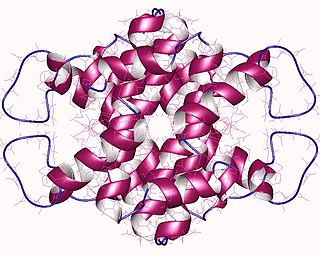Hydrolase is a class of enzymes that commonly perform as biochemical catalysts that use water to break a chemical bond, which typically results in dividing a larger molecule into smaller molecules. Some common examples of hydrolase enzymes are esterases including lipases, phosphatases, glycosidases, peptidases, and nucleosidases.
In enzymology, an acylpyruvate hydrolase (EC 3.7.1.5) is an enzyme that catalyzes the chemical reaction

In enzymology, an acylphosphatase (EC 3.6.1.7) is an enzyme that catalyzes the hydrolysis of the carboxyl-phosphate bond of acylphosphates, with acylphosphate and H2O as the two substrates of this enzyme, and carboxylate and phosphate as its two products:
In enzymology, an adenosine-tetraphosphatase (EC 3.6.1.14) is an enzyme that catalyzes the chemical reaction
In enzymology, an adenylylsulfatase is an enzyme that catalyzes the chemical reaction
In enzymology, an ADP-sugar diphosphatase (EC 3.6.1.21) is an enzyme that catalyzes the chemical reaction
In enzymology, an ATP diphosphatase (EC 3.6.1.8) is an enzyme that catalyzes the chemical reaction
In enzymology, a bis(5'-adenosyl)-triphosphatase (EC 3.6.1.29) is an enzyme that catalyzes the chemical reaction
In enzymology, a bis(5'-nucleosyl)-tetraphosphatase (symmetrical) (EC 3.6.1.41) is an enzyme that catalyzes the chemical reaction
In enzymology, a CDP-glycerol diphosphatase (EC 3.6.1.16) is an enzyme that catalyzes the chemical reaction
In enzymology, a FAD diphosphatase (EC 3.6.1.18) is an enzyme that catalyzes the chemical reaction
In enzymology, a NAD+ diphosphatase (EC 3.6.1.22) is an enzyme that catalyzes the chemical reaction

In enzymology, a nucleoside-diphosphatase (EC 3.6.1.6) is an enzyme that catalyzes the chemical reaction
In enzymology, a phosphoadenylylsulfatase (EC 3.6.2.2) is an enzyme that catalyzes the chemical reaction

In enzymology, a phosphoribosyl-ATP diphosphatase (EC 3.6.1.31) is an enzyme that catalyzes the chemical reaction
The enzyme wax-ester hydrolase (EC 3.1.1.50) catalyzes the reaction
In enzymology, a 1-aminocyclopropane-1-carboxylate deaminase (EC 3.5.99.7) is an enzyme that catalyzes the chemical reaction
In enzymology, a 1-pyrroline-4-hydroxy-2-carboxylate deaminase (EC 3.5.4.22) is an enzyme that catalyzes the chemical reaction
In enzymology, an allophanate hydrolase (EC 3.5.1.54) is an enzyme that catalyzes the chemical reaction
In enzymology, a hydroxyisourate hydrolase (EC 3.5.2.17) is an enzyme that catalyzes the chemical reaction



